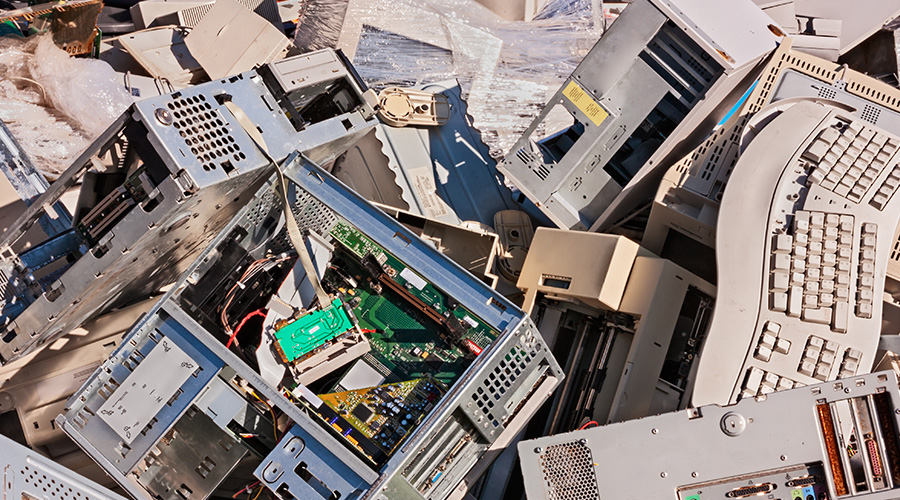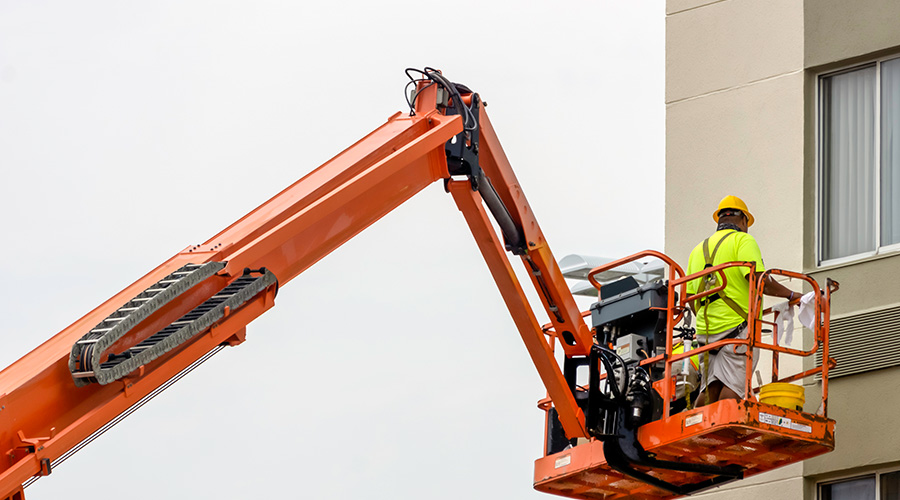Hazmat Management Matters
To comply with hazardous waste regulations, managers need a clear understanding of the wastes their facilities generate
Hazardous material management is a rising priority in many institutional and commercial facilities. As federal scrutiny grows along with public awareness of the potential problems these materials present, the pressure grows on managers to better understand the hazardous waste their operations generate.
The regulatory environment also is heating up. Under federal and state environmental regulations, all wastes generated from a facility must be evaluated to see if they are hazardous. Each state also has specific regulations on handling and disposing of hazardous waste.
Sizing up the Problem
A manager’s ability to comply with hazardous waste regulations depends on an understanding of what constitutes a hazardous waste.
For a waste to be deemed hazardous, the U.S. Environmental Protection Agency (EPA) must list it under the Resource Conservation and Recovery Act (RCRA) regulations — i.e., listed wastes. If a waste does not appear on one of these lists, it still might be a hazardous waste if it has one or more of the following characteristics:
-
It is easily combustible or flammable. This is called an ignitable waste, which can include solvents, paint wastes and gasoline.
-
It corrodes metals and other materials or is very acidic or very alkaline. Corrosive wastes can include battery acid, caustic paint strippers, and some alkaline or lime-based floor cleaners.
-
It is unstable and explodes or produces toxic fumes, gases, and vapors when mixed with water or under other conditions, such as heat or pressure. Examples of reactive waste are certain cyanides or sulfide-bearing wastes.
-
It is harmful or fatal when ingested or absorbed, or it leaches toxic chemicals into the soil or groundwater. Toxic wastes can include gasoline, solvents and paint solids.
The toxicity characteristic leaching procedure (TCLP) is a standard test used to determine the toxicity of a solid waste. The test is based on the ability of a waste to leach specific metals and chemicals. If the leachate contains more than the regulatory level for a specific chemical, the material is considered a hazardous waste.
The EPA lists a waste because it has been shown to be harmful to health and the environment when not managed properly. The EPA regulations — 40 CFR Part 261 — list more than 400 hazardous wastes. But even if a waste is not found on any of these federal lists, it still might be on a state hazardous waste list, which managers can review at www.epa.gov/epawaste/laws-regs/state/index.htm.
As of August 2005, mercury-containing equipment is a new universal waste category. Mercury is used in several types of instruments, including switches, barometers, meters, temperature gauges, pressure gauges, and sprinkler-system contacts. Among the common types of mercury-containing waste are these:
- BATTERIES. These include nickel-cadmium (NiCad) and small sealed lead-acid batteries, which are found in many common items, including electronic equipment, mobile telephones, portable computers, and emergency backup lighting.
-
AGRICULTURAL PESTICIDES. These chemicals include those recalled under certain conditions and unused pesticides collected and managed as part of a waste-pesticide-collection program.
-
THERMOSTATS. These products can contain as much as 3 grams of liquid mercury and are located in almost any building, including institutional, commercial and industrial facilities.
-
LAMPS. These include the bulb or tube portion of electric lighting devices. Examples of common universal waste electric lamps include, but are not limited to, fluorescent, high-intensity-discharge, neon, mercury vapor, high-pressure-sodium, and metal-halide lamps. Many used lamps are considered hazardous wastes under the RCRA because they contain mercury or occasionally lead.
For more common hazardous wastes, see the accompanying article below.
Regulatory Recap
Universal waste regulations have streamlined hazardous waste management standards for the federal universal wastes, including batteries, pesticides, thermostats and lamps. Universal waste regulations govern the collection and management of these widely generated materials. The regulations facilitate the environmentally sound collection, and they increase the proper recycling or treatment of universal wastes.
They facilitate programs developed to reduce the quantity of these wastes in municipal solid waste landfills or combustors. They also ensure that universal wastes subject go to appropriate treatment or recycling facilities.
States can modify the universal waste rule and add additional universal waste in individual state regulations, so managers should check with the state for the exact applicable regulations. To review state-specific universal waste regulations, managers can access the web site of the U.S. Environmental Protection Agency (EPA) www.epa.gov/epaoswer/hazwaste/id/univwast/uwsum.htm.
Small and large facilities that generate hazardous wastes in the universal waste categories can use the more streamlined requirements under the universal waste rule.
The universal waste rule eases the regulatory burden on facilities that generate these wastes. Facilities that produce less than 100 kilograms — 220 pounds — of universal wastes per month can handle their universal wastes under the universal waste regulations or as a conditionally exempt small quantity generator.
Handling and Storing
Hazardous waste management begins with proper material labeling. New technologies allow managers to easily print compliant labels, including warnings and symbols from their computers. Manufactur-ers also have introduced advances in areas of spill control and fire protection.
Special considerations for hazardous wastes include ensuring adequate ventilation through the use of hoods or localized exhaust systems. Managers also should be sure to ground and bond containers during transfer of flammable liquids to prevent static sparking.
Employees should not smoke, eat or drink in waste storage areas, and they should not mix incompatible chemicals or store incompatible chemicals together unless a separate, secondary containment is provided.
Managers also need to remember that many chemicals are hazardous in more than one manner. For example, concentrated hydrogen peroxide is toxic, corrosive, flammable, and reactive, and it is a strong oxidizer. Employees should read the material safety data sheet (MSDS) for hazard information on all chemicals used in a facility.
Finally, managers will find significant developments in the tools used in handling and transporting hazardous wastes. These developments include transportation carts with built-in secondary spill control, various sizes of spill-control funnels, and spill kits specifically designed for vehicles and shop areas.
Waste Minimization
The easiest and most cost-effective way of managing any waste is to avoid generating it in the first place. Managers can decrease the amount of hazardous waste their organizations produce by developing a few good habits. These procedures generally save organizations money, and they prevent accidents and waste. To help reduce the amount of waste an organization generates, managers can consider the following practices:
-
Do not mix non-hazardous waste with hazardous waste because once anything mixes with listed hazardous waste, the whole batch becomes hazardous.
-
Change materials or processes, or both. Managers can cut costs and increase efficiency by replacing a material or a process with another that produces less waste.
-
Recycle and reuse materials. Many managers routinely put useful components — such as oil, solvents, acids, and metals — back into productive use rather than dispose of them. Some managers also have taken additional waste-minimization actions, such as using fewer solvents to do the same job, using solvents that are less toxic, or switching to a detergent solution.
-
Safely store hazardous products and containers. Managers can avoid creating more hazardous waste by preventing spills and leaks. Store hazardous product and waste containers in secure areas, and inspect them frequently for leaks.
-
Make a good-faith effort. Small-quantity generators do not have to document their waste-minimization activities or create a waste-minimization plan. Managers do, however, need to certify on waste manifests that they have made a good-faith effort to minimize waste generation when waste is sent off site.
Hazardous wastes require careful management within a facility. Identifying hazardous waste streams, minimizing or eliminating these streams, and proper labeling and handling of these materials will allow managers to address hazardous wastes in a safe, efficient and economical manner.
Jeffery C. Camplin, CSP, CPEA is president of Camplin Environmental Services Inc. in Rosemont, Ill. He is the administrator of the environmental practice specialty of the American Society of Safety Engineers, where he provides environmental support to its 30,000 safety professional members.
Targeted Activities and Materials
Institutional and commercial facilities generate a host of common hazardous wastes. The activities listed below often generate hazardous wastes, but some activities taking place in facilities generate hazardous wastes that are not listed here.
Among the activities are these:
-
Equipment and building repair involving degreasing, equipment cleaning, rust removal, paint preparation, painting, paint removal, spray booth, spray guns, and brush cleaning. Hazardous wastes generated from these activities include: spent cleaning or degreasing solvents such as xylene, acetone, toluene, benzene, methanol, methylene, chloride, 1,1,1-trichloroethane, carbon tetrachloride, and trichloroethylene; still bottoms and solvent wipers; old paint and paint booth filters; and mineral spirits or stoddard solvents.
-
Pesticide end-user application and cleanup, including used and unused pesticides, solvent wastes, ignitable wastes, spill-contaminated soil, contaminated rinse water, and empty containers.
-
Educational, vocational shops, maintenance areas and garages involving automobile engine and body repair, degreasing, rust removal, paint preparation, spray booth, spray guns, brush cleaning, paint removal, tank cleanout, installing lead-acid batteries, oil and fluid replacement, metalworking, graphic arts-plate preparation, and woodworking. Hazardous wastes include ignitable materials, solvents, acids, bases, paint wastes, batteries, used oil, and unused cleaning chemicals.
-
Printing, allied industries and photography involving plate preparation, stencil preparation for screen printing, photo-processing, developing negatives/prints, stabilization system cleaning, and general cleanup. Hazardous wastes include acids, bases, heavy-metal wastes, solvents, toxic wastes, ink, unused chemicals, acid regenerants, cleaners, ignitable wastes, and silver.
— Jeffrey C. Camplin
|
Related Topics:











